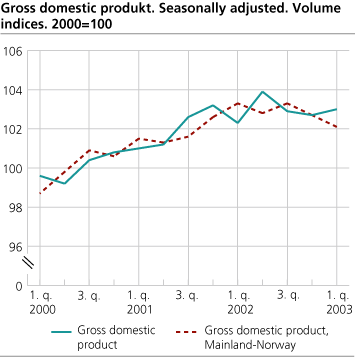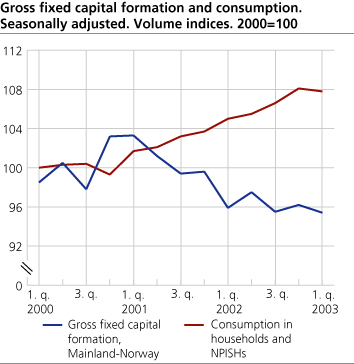Content
Published:
This is an archived release.
Reduced activity in mainland economy
Gross Domestic Product for Mainland Norway declined through the 4 t h quarter of 2002 and the 1 s t quarter of 2003 according to new preliminary seasonally adjusted figures from the quarterly national accounts.
The figures show a decrease in the GDP for Mainland-Norway of 0.6 per cent from the 3 r d to the 4 t h quarter last year and a further decrease of 0.6 per cent from the 4 t h quarter to the 1 s t quarter of this year. Value added for electricity supply contributed to the decrease in growth in both quarters.
Lower development in final consumption expenditure among households
According to preliminary seasonally adjusted volume figures, final consumption expenditures among households and Non-Profit Institutions Serving Households (NPISH) fell by 0.2 per cent from the 4 t h quarter of last year to the 1 s t quarter of 2003. The corresponding quarterly growth rates were in the 3 r d and 4 t h quarter of 2002 1.1 and 1.3 per cent respectively. Abnormally low seasonal temperatures throughout large areas of the country in the 4 t h quarter most likely contributed to household consumption of electricity in the current quarter. The growth-path in household consumption excluding electricity presents a more accurate picture of the underlying development in household consumption. The quarterly growths in household consumption excluding electricity were 0.8 and 0.3 per cent in the 4 t h quarter 2002 and the 1 s t quarter 2003. In the 1 s t quarter of 2003, final consumption expenditure in general government had an increase of 0.5 per cent.
Continued low investment activity
The seasonally adjusted figures show continued slow development in gross fixed capital formation in Mainland Norway. The growths were in the 4 t h quarter 2002 and in the 1 s t quarter 2003, 0.8 and -0.8 per cent respectively. The figures show differences in the development among different mainland industries; while a distinct decrease occurred within manufacturing and mining from the 4 t h to the 1 s t quarter. Service industries excluding general government showed a clear increase.
Gross capital formation within the oil and gas extraction industries including pipeline transport increased by 6.2 and 6.5 per cent in the 4 t h quarter of 2002 and in the 1 s t quarter of 2003.
Low growth in exports of traditional goods
According to the seasonally adjusted figures, the volume in export of traditional goods increased by 0.3 per cent from the 4 t h quarter to the 1 s t quarter, after a decrease of 3.7 per cent from the 3 r d to the 4 t h quarter last year. In the national accounts, external trade including aircraft is grouped under imports and exports of traditional goods. By calculating exports of traditional goods - not including aircraft - a clearer perspective of external demand directed towards production in Norway can be determined. The growth rates in exports of traditional goods excluding aircraft were 0.9, -3.2, and 1.1 per cent respectively in the 3 r d and the 4 t h quarters of 2002 and the 1 s t quarter of 2003. The growth in exports of crude oil and natural gas were in the 4 t h and 1 s t quarters 0.1 and 1.1 per cent.
The preliminary figures for the volume of import of traditional goods show an increase of 3.0 per cent from the 3 r d to the4 t h quarter last year and a decrease of 0.8 per cent from the 4 t h to the 1 s t quarter this year. The growth in imports of traditional goods excluding aircraft and aircraft parts was calculated at 1.6, 1.5 and 1.2 for the 3 r d , 4 t h and 1 s t quarters. The growth in total imports was 2.3 per cent in the 4 t h quarter 2002 and in the 1 s t quarter 2003.
Pronounced reduction in manufacturing industries
The seasonally adjusted growth in GDP for Mainland Norway was -0.6 per cent in both the 4 t h quarter of 2002 and the 1 s t quarter of 2003. In electricity supply, the growth was -6.4 and -18.3 per cent for the 4 t h and 1 s t quarters. The production in the energy industries often shows large variations over time. The production may be affected by random variations in, among other things, precipitation. If one removes value added for the energy producing industries from the GDP for Mainland Norway, the growth is -0.4 and -0.2 per cent for the 4 t h and the 1 s t quarters. For total GDP, the growth was -0.2 and 0.3 per cent.
The preliminary figures show a reduction in value added in manufacturing throughout the second half of 2002 and throughout the 1 s t quarter of 2003. The quarterly growths in the 3 r d , 4 t h , and 1 s t quarters were -1.9, -1.9, and -2.5 per cent respectively. The preliminary figures show that the price in manufacturing production, seasonally adjusted, showed nearly no growth throughout the 4 t h quarter 2002 and the 1 s t quarter of 2003.
For employed persons and total hours worked, preliminary unadjusted figures from the quarterly national accounts are available. The preliminary unadjusted figures for total employed persons show a decrease of 0.6 per cent for the 1 s t quarter of 2003, in compared with the 1 s t quarter of 2002. For the 4 t h quarter of 2002, the corresponding growth rate was -0.5 per cent. In the 1 s t quarter, the annual growth rate for the number of employed persons in manufacturing was -4.2 per cent, while the rate for the 4 t h quarter was -2.5 per cent. The preliminary figures show a decrease on an annual basis for the number of employed persons in general government. In the 1 s t quarter, the decrease was 0.5 per cent. The employment figures also show a decrease for most of the service industries. Domestic trade, repair of vehicles, etc were the only major industry groups to show positive growth in employment numbers in the 1 s t quarter when the growth was 2.3 per cent.
For total hours worked, the annual growth was estimated at 3.3 per cent for the 1 s t quarter. The growth must be viewed in connection with the fact that Easter and spring holidays were in the 1 s t quarter last year, while this year they occurred in the 2 n d quarter.
Revised figures for 2002
Statistics Norway's publication cycle for the national accounts includes the publication of figures for the 1 s t quarter of the current year, released in June, newly revised account figures for the entire previous year. With this practice, we are able to incorporate more accurate and more detailed accounts for general government, which only became available after the previous publication of figures. The revised figures for 2002 are still considered to be preliminary.
The new preliminary figures for 2002 show on the volume side only small changes in the total demand and production. The annual growth in GDP for Mainland Norway for the entire year of 2002 has been adjusted downwards from 2.3 to 2.1 per cent. The annual growth in the volume of total exports has not been revised. The growth in total consumption expenditure by general government has been adjusted from 4.5 to 3.2 per cent. Intermediate consumption was adjusted downwards, though a reduction in estimates was also made for compensation of employees. The basis for the revision of figures for general government was, among other things, that Statistics Norway has gained access to new and more encompassing account reports from municipal and county governments, in addition to new and better account information from the state hospital institutions. The growth in consumption expenditure by households and Non-Profit Institutions Serving Households (NPISH) has increased from 3.3 to 3.6 per cent. The revision can mainly be contributed to revise estimates of household purchases of vehicles. Information on how car purchases are distributed among corporations and private households has been incorporated into the statistics. The gross fixed capital formation has been only slightly adjusted from the previous publication.
| Gross domestic product 1. quarter 2002 to 1. quarter 2003. Percentage change in volume from the previous period (seasonally adjusted) |
| 2001 | 2002 | 1. quarter 2002 | 2. quarter 2002 | 3. quarter 2002 | 4. quarter 2002 | 1. quarter 2003 | |||||||||||||||||||||||||||||||||
|---|---|---|---|---|---|---|---|---|---|---|---|---|---|---|---|---|---|---|---|---|---|---|---|---|---|---|---|---|---|---|---|---|---|---|---|---|---|---|---|
| Gross domestic product (GDP) | 1.9 | 1.0 | -0.8 | 1.5 | -1.0 | -0.2 | 0.3 | ||||||||||||||||||||||||||||||||
| Mainland-Norway | 1.7 | 1.3 | 0.7 | -0.6 | 0.5 | -0.6 | -0.6 | ||||||||||||||||||||||||||||||||
| Petroleum activities and ocean transport | 2.7 | 0.0 | -5.4 | 8.0 | -5.3 | 0.8 | 3.0 | ||||||||||||||||||||||||||||||||
| Final domestic use of goods and services | 0.4 | 2.1 | 2.1 | 0.3 | 0.0 | 1.1 | 0.8 | ||||||||||||||||||||||||||||||||
| Final consumption exp. of households and NPISHs | 2.6 | 3.6 | 1.3 | 0.5 | 1.1 | 1.3 | -0.2 | ||||||||||||||||||||||||||||||||
| Final consumption exp of general government | 2.7 | 3.2 | 3.1 | -3.2 | 2.4 | -0.2 | 0.5 | ||||||||||||||||||||||||||||||||
| Gross fixed capital formation | -4.2 | -3.6 | -6.2 | 8.0 | -7.6 | 6.4 | -0.4 | ||||||||||||||||||||||||||||||||
| Exports | 4.1 | -0.5 | -5.9 | 6.0 | -3.8 | -1.0 | 0.7 | ||||||||||||||||||||||||||||||||
| Imports | 0.9 | 1.7 | -1.4 | 5.3 | -2.9 | 2.3 | 2.3 | ||||||||||||||||||||||||||||||||
| Total employed (percent change from the same quarter previous year) | 0.5 | 0.2 | 0.6 | 0.6 | 0.3 | -0.5 | -0.6 | ||||||||||||||||||||||||||||||||
The growth in GDP in Mainland Norway for 2002 is calculated at 1.3 per cent, the same as previously published in March of 2002. The reduction in compensation of employees in general government resulted in a decrease in the estimates of value added for general government from 1.0 to 0.0 per cent. Incorporation of more accurate constant price figures for indirectly measured bank and finance services (FISIM), caused a revision in value added within domestic trade and an upward adjustment in the contribution from taxes and investment fees. This explains why the growth in GDP for Mainland-Norway remained unchanged.
Tables
Contact
-
Pål Sletten
E-mail: pal.sletten@ssb.no
tel.: (+47) 99 29 06 84
-
Ingunn Sagelvmo
E-mail: ingunn.sagelvmo@ssb.no
tel.: (+47) 40 90 26 32
-
Pia Tønjum
E-mail: pia.tonjum@ssb.no
tel.: (+47) 48 99 12 07
-
Kristian Gimming
E-mail: kristian.gimming@ssb.no
tel.: (+47) 91 88 39 06


